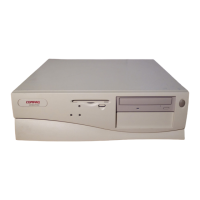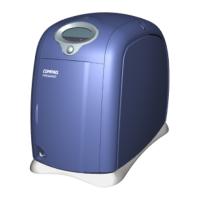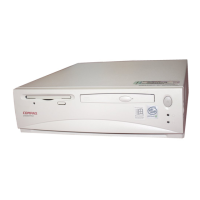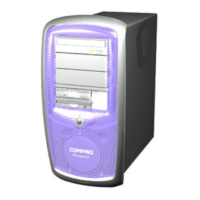Technical Reference Guide
Compaq iPAQ Series of Desktop Personal Computers
Second Edition - February 2001
3-5
3.3 MEMORY SUBSYSTEM
The iPAQ 1.0/1.2 system supports PC100 SDRAM for system memory. The iPAQ 2.0 system
supports PC133 SDRAM DIMMs. These systems provide two 168-pin SDRAM DIMM sockets
that accommodate single- or double-sided DIMMs. DIMMs should always be installed starting
with the socket closest to the GMCH and/or processor These systems are designed for using
non-ECC DIMMs only.
If using memory modules from third party suppliers the following DIMM type is recommended:
For iPAQ 1.0/1.2 models: 100-MHz (PC100) unbuffered non-ECC RAM supporting CAS
latency (CL) 2 or 3 with a data access time (clock-to-data out) of 9.0 ns or less @ CL=2 or
CL=3.
The 82810E GMCH supports 16-, 64-, and 128-Mb technology DIMMs for a maximum of 256
megabytes of memory space (with two 128-MB DIMMs).
NOTE: The 82810e GMCH performs memory accesses at 100 MHz regardless of
the FSB frequency.
For iPAQ 2.0 models: 133-MHz (PC133) unbuffered non-ECC RAM supporting CAS latency
(CL) 2 or 3 with a data access time (clock-to-data out) of 9.0 ns or less @ CL=2 or CL=3.
PC100 DIMMs may be used with a slight reduction in performance.
The 82815 GMCH supports 16-, 64-, 128-, and 256-Mb technology DIMMs for a maximum of
512 megabytes of memory space (with two 256-MB DIMMs).
The RAM type and operating parameters are detected during POST by the system BIOS using the
serial presence detect (SPD) method. This method employs an I
2
C bus to communicate with an
EEPROM on each installed DIMM. The EEPROM holds the type and operating parameter data.
The supported format complies with the JEDEC specification for 128-byte EEPROMs. This
system also provides support for 256-byte EEPROMs to include additional Compaq-added
features such as part number and serial number. The SPD format as supported in this system is
shown in Table 3-3.
The key SPD bytes that BIOS checks for compatibility are 2, 9, 10, 18, 23, and 24. If BIOS
detects EDO DIMMs a “memory incompatible” message will be displayed and the system
will halt. Once BIOS determines the DIMM type the DRAM speed and CAS latency is checked
based on the following criteria:
Access
from
Bus Speed Cycle Time
Clock
100/133 MHz 10 ns 6 ns @ 50 pf loading
Only CAS latencies of 2 or 3 are supported. If DIMMs with unequal CAS latencies are installed
then operation will occur based on the DIMM with the greatest latency.
On iPAQ 2.0 systems, if the BIOS detects an incompatible DIMM the NUM LOCK will blink for
a short period of time during POST and an error message may or may not be displayed before the
system hangs.

